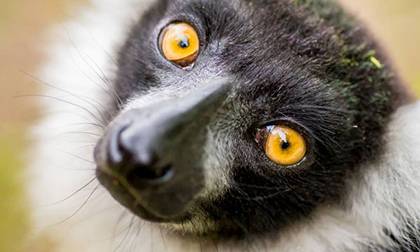Adopt a Lemur at the Annual Lemurpalooza Festival Saturday

Lush green canopies hang overhead as visitors walk about the Duke Lemur Center. From inside an enclosure the small, bug-eyed furry head of a red ruffed Lemur peeks out from his hammock, his curious eyes matching the curiosity of those who are coming to see him.
Red ruffed lemurs, mouse lemurs and many others will be center stage, as the Duke Lemur Center hosts its 5th semi-annual Lemurpalooza event from 5 – 8 p.m. Saturday, June 4. The center is located at 3705 Erwin Rd, Durham.
“We want people to have fun,” said Chris Smith, educational manager at the center. “Lemurpalooza is an opportunity for the community to come meet the lemurs and the center.”
Families will be able to tour the facilities and see some of the 250 lemurs from the more than a dozen species housed at the center, learn about their habits and issues that threaten them, as well as receive fun facts and an experience literally not available anywhere else. The center is the largest collection of lemurs in the country.
As well as viewings, seven lemurs will be available for adoption during the event. Adoptions start at $50, and can be as much as $7400, the annual cost for the center to take care of one lemur. The lemurs up for adoption are:
- Raven, the center’s ‘movie star’. She recently had an appearance on the IMAX documentary Island of Lemurs: “Madagascar.”
- Tasherit, a crowned lemur mother of two young boys.
- Teres, a ring-tailed lemur researcher who can find food in a puzzle box faster than you can blink an eye.
- Presley, a blue-eyed black lemur named after the blue-eyed ‘King of Rock ‘n’ Roll.’
- Pompeia, a six-year-old Coquerel’s Sifaka and recent mother.
- Grendel, a male aye-aye. The Duke Lemur Center has had more success at breeding aye-ayes than any other institution in the world.
- Thistle, a teacup-sized female mouse lemur. Mouse lemurs develop Alzheimer’s-like symptoms as they age, so DLC researchers hope non-invasive mouse lemur research will help us better understand the aging brain.
“Adopters receive an adoption package featuring their lemur adoptee,” said Janice Kalin, community and foundation relations manager for the center. “Photos and a personality profile are included, as well as quarterly updates on their adoptee. It’s always been a great family and community event. We sell out each year.”
In addition to lemurs and food trucks, there will also be music and games including a Lemurpalooza scavenger hunt. Educational docents will be posted about the facilities, and experts on each of the individual species will also be present.
“One pillar of the center is to inspire the next generation of scientists and conservationists,”Kalin said. “With the different scientists and experts present, kids will get to see the different branches associated with conservationism.”
“I like watching the kids fall in love with the animals,” Kalin said. “The kids get to get up close and personal with the lemurs. The lemurs are all very curious and it’s an enriching experience for them.”
“When you get to work with lemurs, you gain a real appreciation for them,” Smith said. “Lemurs are magnetic, and just their cuteness makes you fall in love with them.”
Smith said the history of the lemur is an unusual one, and that their story gives him a sense of duty to them. Lemurs traveled to Madagascar from African via rafts, logs or "carpets of vegetation" around 40-50 million years ago, where they then evolved into numerous variants.
Picnic-style dinners will be provided by NOSH, but families are welcome to bring their own picnic food. Reservations are required. Call 919-401-7252 to reserve your spot. Tickets are $50 per car and are fully tax deductible.
Eric O'Neal is a senior at NC Central University, who is working this summer as an intern with Duke's Office of News and Communications.